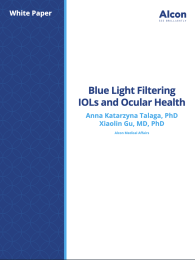

Key Messages:
• Our current lifestyle exposes us to an abundance of blue light in our daily lives in the form of laptops, cell phones and tablets
• Short wavelength/high energy blue light with an excitation peak around 440 nm, has a negative effect on retinal health as it leads to creation of free radical oxygen species which have a damaging effect on retinal cells, including the retinal pigmented epithelium (RPE) cells and photoreceptors
• Experimental evidence suggests that blue light induces retinal toxicity and damage
• Clinical studies support that there are no clinically meaningful differences between short term BCVA and functional vision between blue-light filtering (BLF) and non-BLF IOLs and that BLF IOLs do not interfere with circadian rhythms and mood
• Clinical evidence shows that BLF IOLs reduced photostress recovery time and glare disability
• Clinical studies have not definitively demonstrated a protective benefit of blue-light filtering lenses on macular health

